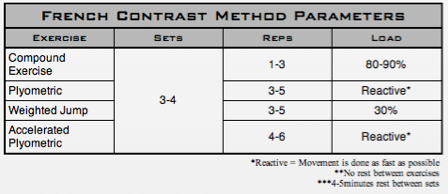When
I was an intern at the University of Minnesota back in 2009, I had the
opportunity to work under renown S&C coach Cal Dietz. Cal is known for his Tri-Phasic training
principles, and within the tri-phasic program he has taken The French contrast
method and brought it to public awareness.
The French Contrast was originally developed by the French track and field coach, Gilles Cometti, but it has been Dietz who has taken this method and molded into a digestible piece of for S&C coaches.
The
concept of the French Contrast is it’s a combination of complex and contrast
methods, molded into one. The idea is to
use 4 exercises, to push the physiological responses of the athlete and train
all along the force-velocity curve.
Here
is Dietz chart from Tri-Phasic as his parameter for developing a French
Contrast. As you can see, you go from a
heavy compound lift and follow it up with a plyometric activity (complex
training). Then you perform a power
movement with about a 30% load (contrast training from main compound), and
finally finish it up with an Accelerated or Assisted plyometric activity.
 |
| (Photo Credit: Triphasic Training - Cal Dietz) |
As I’ve gone through years and years of playing around with
the French Contrast, I’ve made some modifications in terms of order, rest
periods, different names, and specifications for certain types of
athletes. Much is still the same, but
what I tend to do now is just travel right down the F-V curve, but I also allow
30-40 seconds between each exercises – Deitz recommends only about 5-10 seconds
of rest.
So here’s what our typical template will look like.
Now with many exercises, you can’t always perform an
assisted method, so in those cases this is what our template looks like.
Now most templates I’ve seen on the French Contrast are the
exact same, and lack some specificity to the athletes adaptation needs. The lower body protocol is typically the
approach I see, but as you will see we’ve rounded up a small sample of
protocols we’ll use for specific adaptations or for specific athletes’ needs.
Before we start, understand the French Contrast is not for
novice athletes – it’s for athletes with some solid experience and good levels
of strength. With that being said, I
still use this with young athletes (9-10th Grade) who have been with
me for sometime and exhibit proficiency in their movements. On the other hand, just because I have a
Senior in college or a professional athlete, doesn’t mean I’ll use the French
Contrast – again as long as they exhibit quality movement and have solid
strength levels I’ll program some different French Contrast protocols - it comes down to demonstrating movement competency rather than just purely age.
Lower Body Protocol
1. Back Squat
2. Hex Bar Jump Squat
3. Hurdle Hops
4. Band Assisted Jump Squat
Upper Body Protocol
1. Swiss Bar Bench Press
2. Explosive Bench Push-Ups
3. Supine Med Ball Punch
4. Band Assisted Push-Ups
Single Leg Strength Protocol
1. Split Squat
2. Lunge Jumps
3. S/L Hurdle Hops
4. Band Assisted Split Squat
Max Velocity #1 Protocol
- Step-Up
- Sprinters Step-Up
- Single Leg Bound
- Wickets or Flying 10-20's
Max Velocity #2
1. Band RDL
2. Lunge Scissor Jumps
3. Speed Reverse Hyper
4. Wickets or Flying 10-20's
Acceleration Protocol
1. Hip Thrust
2. Jammer Sprint
3. Single Leg Sled Bound
4. Band Assisted Acceleration
Acceleration #2
1. S/L Hip Thrust
2. Band Accel
3. Alternating Bound
4. Falling Start
Vertical Protocol
1. Hex Bar Deadlift
2. Band Resisted Jump Squat
3. Depth Jump
4. Band Assisted Jump Squat
Horizontal Protocol
1. Hip Thrust
2. Band Resisted SLJ
3. Repeated Sled SLJ
4. Repeated 3-SLJ
Lateral Protocol
1. Lateral Lunge
2. Lateral Sled Pull
3. Heidens
4. Russian Plyo’s
Rotational Protocol
1. Lateral Lunge
2. Jammer Rotate & Punch
3. Lateral Bound to Med Ball Punch
4. Lateral Rotational Bound
Go Get 'Em!


